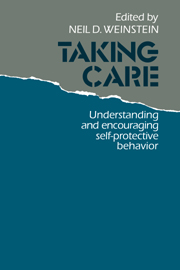Book contents
- Frontmatter
- Contents
- List of contributors
- Acknowledgments
- Introduction: studying self-protective behavior
- I Theoretical perspectives
- 1 Behavioral decision theory perspectives on protective behavior
- 2 Social learning theory and preventive behavior
- 3 The role of emotion and psychological defense in self-protective behavior
- 4 The diffusion of innovations perspective
- 5 Cultural influences on prevention and the emergence of a new health consciousness
- II Research and prevention programs for specific hazards
- III Conclusion
- Index
1 - Behavioral decision theory perspectives on protective behavior
Published online by Cambridge University Press: 03 February 2010
- Frontmatter
- Contents
- List of contributors
- Acknowledgments
- Introduction: studying self-protective behavior
- I Theoretical perspectives
- 1 Behavioral decision theory perspectives on protective behavior
- 2 Social learning theory and preventive behavior
- 3 The role of emotion and psychological defense in self-protective behavior
- 4 The diffusion of innovations perspective
- 5 Cultural influences on prevention and the emergence of a new health consciousness
- II Research and prevention programs for specific hazards
- III Conclusion
- Index
Summary
Introduction
What determines whether people will protect themselves against the severe losses that might arise from some rare hazard? What factors underlie the perception and acceptability of risks associated with technology? The answers to questions such as these are vital for understanding how people cope with threats from accidents, diseases, and natural hazards and for helping them manage their lives more effectively in the face of such risks. The role that the study of judgment and decision processes can play in providing answers to these questions will be explored in this chapter. Experiments concerning insurance decisions, risk perception, and evaluation of technological risks will be described, and the implications of this research for matters of public safety and health will be discussed.
Overview
This paper is divided into five sections. It begins with a brief description of the leading normative theory of protective decision making, which proposes that a rational decision maker acts so as to maximize expected utility.
The second section contrasts this idealized view with research on human intellectual limitations showing that people are, at best, “boundedly rational.” In this section, we focus on the problems that occur when people seek to make sense of a probabilistic environment and attempt to resolve the value conflicts arising from decisions about beneficial but hazardous activities. We point out the difficulties people have in thinking intuitively about risk and uncertainty. We argue that people's perceptions of the world are sometimes distorted and that their preferences can be unstable, vague, or inconsistent.
- Type
- Chapter
- Information
- Taking CareUnderstanding and Encouraging Self-Protective Behavior, pp. 14 - 41Publisher: Cambridge University PressPrint publication year: 1987
- 30
- Cited by



